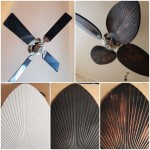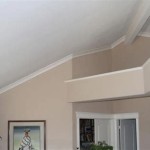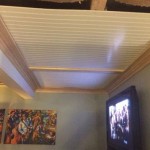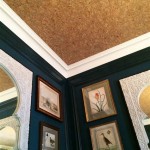How To Clean Water Stains From Popcorn Ceiling
Popcorn ceilings, also known as acoustic ceilings, were a popular choice in residential construction for many years due to their sound-dampening and texture-hiding properties. However, they are notoriously difficult to clean, particularly when dealing with water stains. The porous nature of the material makes it prone to absorbing water, which can lead to discoloration and, in severe cases, structural damage. Attempting to clean a popcorn ceiling requires caution and a systematic approach to avoid further damage and ensure a satisfactory result.
Before commencing any cleaning attempt, it is crucial to identify the source of the water leak and address it. Cleaning the stain without fixing the underlying problem is merely a temporary solution, as the stain will likely reappear. Common sources of water leaks include roof leaks, plumbing issues in the ceiling above, and condensation problems in bathrooms or kitchens. Thoroughly inspect the area above the ceiling to identify and repair the source before proceeding with stain removal.
Furthermore, it is imperative to test the popcorn ceiling for asbestos before undertaking any cleaning or repair work. Many older homes constructed before the 1980s contain asbestos in their popcorn ceiling texture. Disturbance of asbestos-containing materials can release harmful fibers into the air, posing a significant health risk. If you suspect your popcorn ceiling may contain asbestos, consult with a qualified asbestos abatement professional for testing and safe removal or encapsulation options.
Materials and Preparation
Successful water stain removal from a popcorn ceiling hinges on having the right materials and preparing the work area properly. Gather the following items before starting:
*Protective Gear: Wear safety glasses, a dust mask or respirator, and disposable gloves to protect yourself from dust and potential mold spores.
*Drop Cloths: Cover the floor and any furniture directly beneath the stained area with drop cloths to prevent debris and cleaning solutions from causing damage.
*Soft Brush or Duster: Use a soft-bristled brush or a long-handled duster to gently remove loose dust and debris from the affected area. Avoid applying excessive pressure, which could damage the delicate texture of the ceiling.
*Spray Bottle: A clean spray bottle is needed for applying cleaning solutions. Ensure the bottle is clean and free from any residue that could discolor the ceiling.
*Mild Cleaning Solution: A mixture of mild dish soap and water is generally recommended for cleaning popcorn ceilings. Avoid using harsh chemicals or abrasive cleaners, as these can damage the texture and potentially discolor the ceiling. Alternatively, a solution of white vinegar and water can also be effective for removing water stains. The ratio should be approximately one part vinegar to three parts water.
*Clean Sponges or Cloths: Have several clean, soft sponges or cloths available for blotting and gently cleaning the stain.
*Ladder or Stepstool: A sturdy ladder or stepstool is necessary to safely reach the stained area.
*Optional: Ceiling Texture Repair Compound: If the cleaning process results in damage to the texture, a ceiling texture repair compound can be used to patch the area. Ensure the compound matches the existing texture as closely as possible.
Once you have gathered the necessary materials, prepare the work area by covering the floor and furniture with drop cloths. Carefully position the ladder or stepstool to provide comfortable and safe access to the stained area. Ensure the ladder is stable and properly supported before climbing.
Gentle Cleaning Techniques
The key to successfully cleaning water stains from a popcorn ceiling is to use gentle cleaning techniques and avoid oversaturation. The following steps outline a safe and effective cleaning process:
1.Dust and Remove Debris: Use a soft brush or duster to gently remove any loose dust or debris from the stained area. Work in a circular motion, taking care not to apply excessive pressure.
2.Test the Cleaning Solution: Before applying the cleaning solution to the entire stain, test it in an inconspicuous area of the ceiling. This will help determine if the solution causes any discoloration or damage. Apply a small amount of the solution to the test area and blot it gently with a clean cloth. Observe the area for any adverse reactions before proceeding.
3.Apply the Cleaning Solution: Lightly mist the stained area with the cleaning solution using the spray bottle. Avoid saturating the ceiling, as this can cause the popcorn texture to loosen and fall off. The goal is to dampen the stained area, not to soak it.
4.Blot the Stain: Using a clean sponge or cloth, gently blot the stained area. Avoid rubbing or scrubbing, as this can damage the texture and spread the stain. Blotting helps to lift the stain without causing further damage.
5.Repeat as Necessary: Repeat the application and blotting process as needed until the stain is visibly reduced. Allow the ceiling to dry completely between applications. It may take several applications to completely remove the stain.
6.Allow to Dry: Once the stain is removed (or as much as possible without causing damage), allow the ceiling to dry completely. This may take several hours or even overnight, depending on the humidity and ventilation in the room. Avoid using fans or heaters to speed up the drying process, as this can cause uneven drying and potentially damage the ceiling.
If the cleaning process results in minor damage to the texture, such as small pieces falling off, you can use a ceiling texture repair compound to patch the area. Apply the compound according to the manufacturer's instructions, taking care to match the existing texture as closely as possible. Allow the compound to dry completely before painting, if necessary.
Dealing with Stubborn Stains and Potential Issues
Some water stains may be more stubborn and require additional attention. Additionally, there are potential issues that can arise during the cleaning process. Here are some tips for dealing with these situations:
*Stubborn Stains: For persistent stains, consider using a stain-blocking primer specifically designed for ceilings. Apply the primer to the stained area after cleaning and allowing it to dry completely. The primer will help to prevent the stain from bleeding through the paint. Follow the manufacturer's instructions for application.
*Mold Growth: If the water stain is accompanied by mold growth, it is crucial to address the mold before cleaning the stain. Mold can pose a health hazard and should be removed safely. Use a mold-killing solution specifically designed for ceilings, following the manufacturer's instructions carefully. Ensure the area is well-ventilated during the mold removal process. In cases of extensive mold growth, it is advisable to consult with a professional mold remediation service.
*Ceiling Damage: If the cleaning process results in significant damage to the popcorn ceiling, such as large areas of texture falling off, it may be necessary to re-texture the entire ceiling. This is a more involved process that requires specialized tools and skills. Consider hiring a professional contractor to re-texture the ceiling to ensure a uniform and aesthetically pleasing result.
*Paint Touch-Up: After cleaning the water stain and repairing any damage, you may need to touch up the paint on the ceiling. Use a paint that matches the existing color and finish. Apply the paint sparingly, using a small brush or sponge. Blend the paint seamlessly into the surrounding area to avoid creating a noticeable patch.
Throughout the cleaning process, it is important to exercise caution and avoid oversaturation. The porous nature of popcorn ceilings makes them susceptible to damage from excessive moisture. Always test cleaning solutions in an inconspicuous area before applying them to the entire stain. If you are unsure about any aspect of the cleaning process, it is advisable to consult with a professional cleaning service or a contractor specializing in ceiling repair.
Proper ventilation is also crucial during and after the cleaning process. Open windows and doors to allow fresh air to circulate and help the ceiling dry completely. This will help to prevent mold growth and ensure a healthy indoor environment.
By following these guidelines, it is possible to effectively clean water stains from a popcorn ceiling without causing further damage. Remember to be patient and work carefully, and always prioritize safety by wearing protective gear and testing cleaning solutions before applying them to the entire stained area.

Popcorn Ceiling How To Remove An Ugly Stain Drywall Repairman Water Damage Repair

What Should I Do About Water Stains On A Popcorn Williams Painting

How To Fix Water Damage On Popcorn Ceilings

We Have An Old Water Stain On Our Ceiling How Do I Cover It Hometalk

Patch A Water Stained Ceiling Or Textured Diy Family Handyman

How To Clean Popcorn Ceiling Molly Maid

How To Fix Water Damage On Popcorn Ceilings

Super Easy Way To Remove Water Stains From Ceilings Without Paint 1 Step Abbotts At Home

Patch A Water Stained Ceiling Or Textured Diy Family Handyman

Super Easy Way To Remove Water Stains From Ceilings Without Paint 1 Step Abbotts At Home
Related Posts








